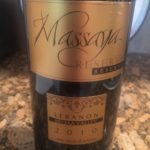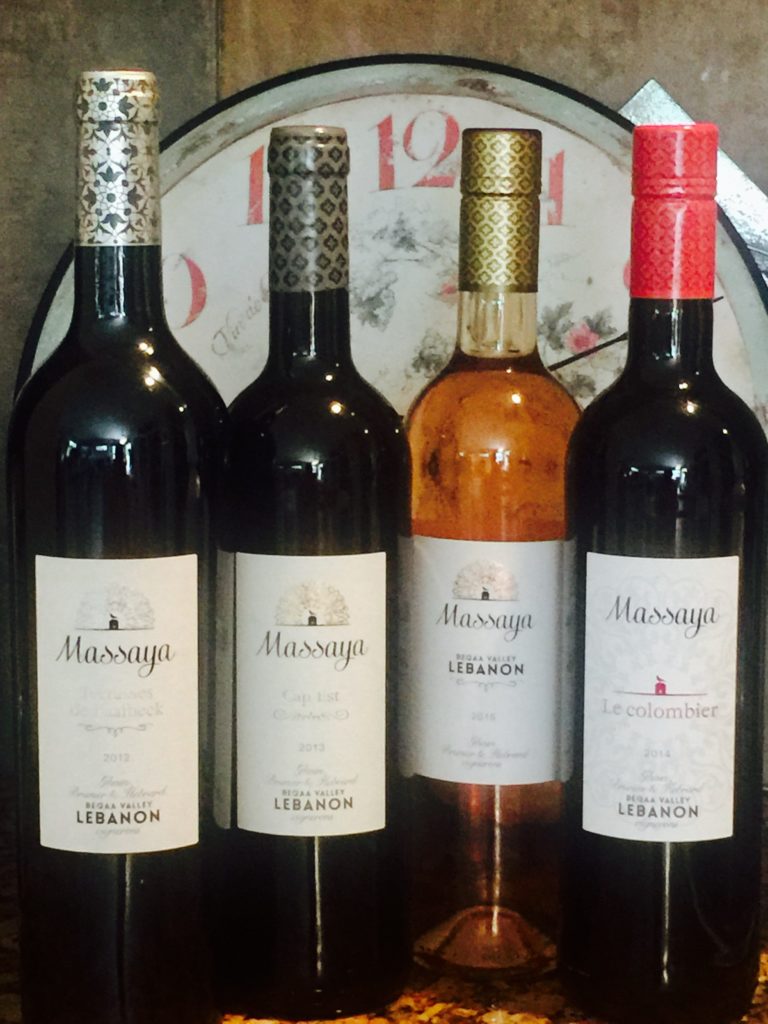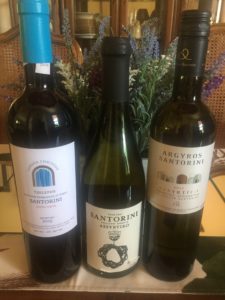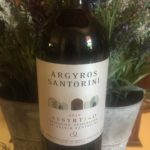When is the last time you sipped on a glass of wine from Lebanon? Or Israel? Or Turkey? For the casual wine taster, the answer is most likely to be “never”! This should seem a little strange since wine was most likely first cultivated somewhere in the Eastern Mediterranean.
Grapevines were first domesticated around 8000 BC in the “Fertile Triangle” part of the world which consists of the Taurus Mountains of eastern Turkey to the northern Zagros Mountains of western Iran to the Caucasus Mountains and Republic of Georgia, Armenia and Azerbaijani. The oldest known winery may have been in a cave in Armenia where primitive wine-making equipment dating back to 4100 BC was discovered. From the Fertile Triangle, grapevines spread to Syria, Iraq, Lebanon, Jordan and Palestine most of which made up the ancient civilization of Phoenicia. The Phoenicians were great traders, sailing and exporting wine all around the Mediterranean. Grape cultivation began on Greece and Crete by about 2200 – 2000 BC with grapevines eventually spreading around the entire Mediterranean.
So what happened to shape the future of winemaking in this part of the world? Religion played a major role in the history of winemaking. After the birth of Islam in the seventh century, by the eighth century the Islamic Muslim empire stretched a long way around the eastern Mediterranean. Islamic law prohibits the consumption of any intoxicants, specifically alcoholic beverages. Christians and Jews continued to make wine primarily for sacramental and medicinal uses, but for the general population wine was no longer legal. Fast forward to the end of the nineteenth century when phylloxera destroyed most of Europe’s vineyards. Eastern Mediterranean and Asian countries seized the opportunity to supply the Christians and Jews with wine for whatever uses appropriate —the Jesuits founded wineries in Lebanon and a Rothschild starting winegrowing once again in Israel. Unfortunately by the late twentieth century, the majority of the world’s wine drinkers lost sight of wines from the Eastern Mediterranean with the exception of two countries – Lebanon and Israel. More about them coming up.
A winelover’s personal discovery!
Anyone who has read any of my previous articles on www.forkandcorkdivine.com will know that this winelover has a great desire to taste and learn about wines from as many wine producing countries as possible. During the past several years, my husband and I have convinced some of our wineloving friends to join us in a number of wine discoveries including sparkling wines from Trentodoc and Franciacorta DOC (Italy), wines of South America and Austria, the Assyrtiko varietal (Santorini, Greece), and the Sangiovese varietal (Italy).
Early in 2017 we had the privilege of tasting the Lebanese wines of Massaya with Sami Ghosn, the winery founder and general manager, at the Waterside Wine Club in Cape Coral, Florida. We so enjoyed the wines of Massaya that we purchased all of their available options, and the vision of sharing them at an in-home Lebanese wine dinner was born! One idea always seems to lead to another — Lebanon quickly expanded to include some other countries of the Eastern Mediterranean. Thus our focus for this article and wine event will be Lebanon, Israel and Greece.
Lebanon
Being one of the oldest areas of wine production in the world dating back 5000 years ago to the Phoenicians who exported their wine to ancient Egypt, Rome, Greece and Carthage. As we mentioned earlier, alcohol production was prohibited under the Muslim Islamic rule except for Christian religious purposes. Jesuit monks planted grape vines in the Bekaa Valley in 1857 which became Chateau Ksara, the country’s first commercial winery. Lebanon wineries have a great French influence due to French occupation after World War I and French Christians who came there during the Crusades. The Christians also developed Arak, which is an ouzo-like spirit flavored with aniseed.
Winemaking in Lebanon is especially challenging due to the political situation of this area of the world. Wars with Israel and attacks from terrorists make for life risking endeavors. Bombings also made it hard to hire employees. Frenchman Yves Morard of Chateau Kefraya was arrested as a spy during the Israeli invasion being released only because he proved that he knew how to make wine. Lebanon also has a long history of conflict including a 20 year civil war. In spite of all the conflict, the Lebanese wine industry, grape growing and winemaking took a new momentum. Along with it came several wineries like Domaine Wardy in 1997 and Massaya in 1998. There were 5 producers then, and there are now around 50 producing approximately 9,000,000 bottles or 750,000 cases a year. Nowadays most wineries plant the noble grapes and give their own twist to international winemaking styles instead of the sweet wines previously made for religious purposes.
Lebanon is approximately 4000 square miles and 1/946 the size of United States. The Bekaa Valley lies at about 1000 meters (.62 miles) above sea level with mountains on each side cresting at 3000 meters (1.8 miles). It has warm sunny days, cool nights, soil of lime and red clay, and a gravely mix in the mountain vineyards. There is little need for irrigation, pesticides or fertilizers. Lebanon is perfectly suited for winegrowing! Over 50% of today’s production goes mainly to the United Kingdom, France and United States.
The grapes, which are on French rootstock, consist of these widely planted French varietals: Cabernet Sauvignon, Syrah, Merlot, Cinsault, Chardonnay, Carignan, Mourvedre, Viognier and Grenache. There are two quality indigenous grapes used and both are white – Obaideh and Merwah. Most winemakers were trained in France. Even the wine bottle labels are often in French. All of this “Frenchiness” makes for good wine, but it does cause a marketing problem if Lebanon wants to become a distinctive wine producer in its own right.
Some of their wines are very distinctive like Chateau Musar reds, which are made from a blend of Cabernet, Carignan and Cinsault, and have a heady, wild taste with a Byzantine-like cinnamon sweetness. This profile seems to have become prevalent in Lebanon’s finest red wines. The Carignan and Cinsault seems to be more suited to the heat in the Bekaa than does the Cabernet. Lebanese wines have been described by some as “pure” with the ability to age well. The future of Lebanese wine making is looking good as long as the country remains stable.
The Ghosn family, owners of the boutique Massaya Winery, was forced to leave Lebanon in the 1970s, but Sami and his brother Ramzi returned to the family estate in the mid-1990s. Sami had been working in the United States as an architect but decided that he wanted to take back their property as the rightful owners and transform the ruins into a high quality production center. Sami says that he slept on the roof of their old home with an AK47 for four months before successfully ridding the home of squatters. By 1994 they were making Arak , the Lebanese ouzo-like spirit, and now export wine to over 20 countries including a white, rosέ and four reds. Their Massaya Blanc is a blend of Sauvignon Blanc, Chardonnay, Clairette, and the local Obaideh. It is a truly unique blend and is fruity but with a long savory finish. The Massaya Rose is a blend of 30-year-old Cinsault, Syrah and just a splash of Cabernet Sauvignon. There are four reds in their line-up: Le Colombier, Terrasses de Baalbeck, Cap Est and the majestic Gold Reserve (50% Cab, 40% Mourvedre and 10%  Syrah). Massaya partnered up early on with Frederic and Daniel Brunier, the owners of Vieux Telegraphe and Dominque Hebrard of Cheval Blanc French wine dynasties which surely had an impact on the Massaya Rhone and Bordeaux-like quality . Ramzi Ghosn is now the winemaker and marketer. They have since expanded from their winery at the Tanail property in the Bekaa Valley and opened a second property at Faqra in 2014 in Mt. Lebanon where they also have a restaurant, bar and event center.
Syrah). Massaya partnered up early on with Frederic and Daniel Brunier, the owners of Vieux Telegraphe and Dominque Hebrard of Cheval Blanc French wine dynasties which surely had an impact on the Massaya Rhone and Bordeaux-like quality . Ramzi Ghosn is now the winemaker and marketer. They have since expanded from their winery at the Tanail property in the Bekaa Valley and opened a second property at Faqra in 2014 in Mt. Lebanon where they also have a restaurant, bar and event center.
Following is a partial list of Lebanon’s wineries with a few of their finest wines. Most vineyards are concentrated in the Bekaa Valley and Mount Lebanon, but you can find them in Batroun, in the south, and elsewhere. Most of those listed here will provide tours and tastings with advanced booking, and the major wineries often feature large complexes for tours and tastings with restaurants, terraces and even classes.
Bekaa Valley
- Domaine Wardy – First in Lebanon to produce single variety wine and renowned for high quality wines. Obeideh, Clos Blanc, Perle du Chateau, Cinsault, Les Cedres, Les Terroirs are most notable.
- Chateau Ksara – The biggest winery with 70% of the country’s production. It got its name from the word Ksar, which was a fortress used during the Crusades. The original wine cellar was a Roman grotto. The Jesuits expanded the caves during World War I to create employment for the people. The civil wars almost put Chateau Ksara out of business. Ch Ksara and Le Souverain are most notable.
- Chateau Kefraya – Next biggest winery; Rosέ, Comtesse de M, Comte de M and Ch Kefraya most notable.
- Massaya – A boutique winery with some very famous business partners : the French wine owners of Vieux Telegraphe and Cheval Blanc. Best known for its Gold Reserve and its vineyard restaurant and tasting room.
- Domaine De Baal
- Chateau St. Thomas – Les Gourmets Rouge, Ch St Thomas, Merlot most notable
- Chateau Qanafar
- Chateau Nakad
- Chateau Marsyas – Also produces wine in Syria, Domaine de Bargylus.
- Chateau Khoury
- Chateau Heritage
- Domaine des Tourelles – Cinsault Vielles Vignes, Domaine des Tourelles Rouge, Marquis de Beys, and Syrah du Liban most notable.
- Chateau Ka
- Cave Kouro
- Chateau Barka
North Lebanon
- Domaine S. Najem
- Coteaux de Bortys
- Clos du Phoenix
- Chateau Sanctus Domaine Marmama
- Batroun Mountains Winery and Vineyard
- Aurora Winery
- IXSIR – An exciting new winery in the north that won a major award for architecture and design. Grande Reserve, El Ixsir most notable .
Mount Lebanon
- Michael Winery
- Nabise Winery
- Iris Domaine
- Chateau Isaac
- Domaine Mar Chaaya
- Chateau Wadih
- Chateau Musar – Probably best known in the West; known for transporting grapes across the front line during the civil war. Their second wine “Hochar” is made in a lighter style for earlier drinking.
- Chateau Florentine
- Chateau Fakra
- Chateau Belle-Vue
- Cave du Monastere St. Jean
- Cave Saint Sauveur Des Peres Trappistes
- Adyar Winery
- Chateau Oumsiyat
South Lebanon
- Karam Wines – First to produce in Lebanon’s southern region. Their Cloud Nine 2013 was awarded the “Prix Special Sommeliers 2015” and voted as “the best wine in the Mediterranean basin”.
Israel
Like Lebanon, Israeli wine making can be traced back to Biblical times, but modern Israeli winemaking has been credited to Baron Edmond de Rothschild who began exploring possibilities of Israeli grape production in 1882. In 1890 the Carmel Winery opened. It stands to reason that the owner of Chateau Lafite-Rothschild should have been able to make good wine, and Carmel, which is still in operation today and the largest producer of Israeli wine, has been a leader in Israeli technical and historical advances. The Baron eventually decided to focus on Bordeaux varietals; however fear of phylloxera that was wiping out French vineyards convinced him to use Chateau Lafitte cuttings that had been planted in Kashmir. Unfortunately the “Indian varieties” were not resistant to phylloxera either and had to be replanted on American rootstock. It seems that the American aphid-like bug called phylloxera particularly liked leaves of imported American grapevines, and the roots of French vines. Grafting French vines onto American rootstock made phylloxera resistant grapevines. European vintners can thank us for that discovery!!!
Most Israeli wine was based upon production of Kosher wines that were exported all over the world to Jewish communities. These wines were sweeter and of various quality. It wasn’t until the 1980s that some talented winemakers came from California, France and Australia bringing with them their modern winemaking skills that led to some boutique wineries turning out international wine competition award winning dry wines. Today there are over 300 boutique wineries that along with the larger brands like Carmel and Golan Heights continue to develop better techniques. When Robert Parker and Hugh Johnson started giving Israeli wines high ratings in the mid-2000s, the rest of the world started to take notice. Decanter World Wine Awards named Carmel’s 2008 Kayoumi Vineyard Syrah the best Syrah in the world in 2010. Golan Heights Winery was named New World Winery of 2012 by Wine Enthusiast magazine.
Wines are definitely New World style with the influx of California and Australian winemakers. The Mediterranean climate means that grapes ripen easily and sometimes too quickly . Many vines are still young and yields may be too high, but as the vines age, they should make better wine.
There are five major grape growing regions in Israel : Galilee, Shimson, Judean Hills, Negev and the Sharon plain. Winemaking in Israel comes with a completely different issue – the geopolitical controversy. Are they in Israeli, Syrian or Palestinian territory? Israel is about the size of the state of New Jersey and has a wide variety of microclimates ranging from mountains to the desert, but the majority of wines are made in the northern more temperate climate. The main grape varieties harvested are Cabernet Sauvignon, Carignan and Merlot with much smaller amounts of Syrah, Petit Verdot and Argaman. Argaman is an Israeli grape, having a much desired good rich color, developed in the early 1990s and is a cross between Carignan and Souzão (a Portuguese grape). It seems that lack of good rich color has been a problem with Israeli wine! Unfortunately the Argaman didn’t pass the quality test. The main whites are Colombard and Muscat of Alexandria with some Chardonnay and Sauvignon Blanc.
Most Israeli wine is kosher, but most wineries are not. How can that be? The large wineries are kosher, but many of the small boutique wineries are not. To be considered Kosher, wine must be handled by observant Jews from the time grapes are crushed. If the wine is boiled or pasteurized, it can be handled by anyone without losing its kosher status. The large producers are Kosher-certified but the boutique winemakers don’t want to relinquish control of their winemaking . Just as an aside, Manischewitz is actually an American brand began in the 1980s by some New England Jewish entrepreneurs who took advantage of quick ripening Concord grapes.
According to www.wines-israel.com there are 60 commercial wineries and 300 wineries in all plus uncounted domestic and garagiste wineries producing about 40 million bottles of wine and 10 million bottles of grape juice. The four largest wineries – Barkan (largest), Carmel (historic), Golan Heights (initiated quality revolution) and Teperberg (largest family owned) – produce over 5 million bottles a year. Tabor, Binyamina, Tishbi, Recanati and Dalton produce between 1-2 million bottles a year. Israelis don’t drink much of it, just an average of 4.6 liters per person. US$40 million of it is exported with over 55% going to United States.
Wine tourism is booming now in Israel. Here are some wineries that offer tours and tastings:
- Golan Heights Winery
- Tishbi Winery
- Flam Winery
- Pelter Winery
- Tulip Winery
- Recanati Winery
- Binyamina Winery
- Tabor winery
- Agur Winery
- Boker Valley Vineyards Farm
- Galil Mountain Winery
- Adir Winery and Dairy
- Netofa Winery
- Kishor Winery
- Carmel Winery
If you are a world traveler winelover, I would consider adding Israel to the list. But if you can’t get there, tasting some Israeli wines right here in Southwest Florida is an inexpensive option! L’chaim!!!
Greece
According to Matt Kramer in his Wine Spectator.com article “25 Ways to Leave Your Wine Love” posted January 3, 2017, one of the 25 wines you should be drinking in 2017 is “Any Greek Wine Other than Retsina: The “new” Greek whites and reds are a revelation. Forget everything you ever thought about Greek wines.” Now is definitely an exciting time for a rediscovery of Greek wine.
It is believed the Phoenician traders introduced the Greeks to the joys of wine during their travels around the Mediterranean. Some reports mention signs of grape cultivation on the island of Crete 4000 years ago. Wine presses were found in Crete tombs dating back 3500 years ago. Cretan wines were renowned then and travelled around the world.
But just how did wine travel 3000 years ago? Goatskin bags, but usually in AMPHORAE. Amphorae are terra cotta jars with two looped handles and usually had a pointed base. Evidently someone made the discovery that wine turned into vinegar was not a pleasant taste. But if the mouth of the amphorae was filled with a clump of fibrous material, such as straw or grass, that had been soaked in pine resin, and then capped with clay, bacteria could not spoil the wine! Even better, if the inside of the porous terra cotta amphorae was coated with resin, evaporation and oxidation was prevented or retarded. The resinous coating was soluble in alcohol; therefore early Greek wines probably tasted like pine pitch – hence the forerunner of today’s retsina wine. If you have tasted retsina, you will immediately relate to that taste. The looped handles of amphorae would have enabled two people to carry the large containers filled with 6 ½ gallons of wine. The pointed base was also functional for storage by burying the container in the sand or placing in special ring stands to hold them erect.
Wine growing and production in Greece suffered through the same issues as the rest of the world: rule by a number of different people, the influence of various religions, and the devastation by phylloxera which arrived during the 1890s in Greece. All of this ruined the country’s wine industry. By the 1960s most Greek wines were sold directly in barrels to people who brought their own jugs. In the mid-1980s, Greece entered the European Union and inexpensive table wine started to move toward wine of better quality. Viticultural techniques improved in the vineyards and in production. Greece now ranks eleventh among the wine-producing countries worldwide with around 600 wineries including some very large companies and many newer, smaller, family-run estates. All of these companies are intent on making quality fine wine. The cheap bulk wine of the old days is left for wine cooperatives.
Greece is just slightly larger than Cuba and consists of 70% mountains and 20% islands. This leaves a small amount of land available for agriculture which includes grapevines and olive trees. Greece has 4000 plus islands which allowed the establishment of many different grape varietals. There are five major winegrowing areas:
- Northern Greece: along the northern coast of the Aegean Sea and inland; Macedonia, Thrace and Epirus are large regions; Goumenissa, Naoussa, Amyndeon, Rapsani and Halkidiki
- Mainland Greece: the northern mountainous part near Thessalia and flatter plains Attica; retsina is made here.
- The Peloponnese and Ionian Islands: a peninsula and the southernmost region of the mainland and the Ionian Islands that surround it. Three regions are Nemea, Mantinia and Patras.
- The Aegean Islands: all have small wine regions such as islands of Lemnos and Samos in the north and Rhodes and Santorini in the south.
- Crete: Largest of all the Greek islands and the fifth largest in the Mediterranean; Archarnes is the most important wine region on the island; lots of GSM type blends are made here.
Seventy-seven indigenous varieties have been identified which also means there are many unpronounceable grape varietals for those of us who don’t speak Greek! Here are some of the most important with a little help for the pronunciation.
Whites:
- Assyrtiko (A seer’ tee ko)– Native to island of Santorini and is dry crisp, riper and oakier.
- Malagousia (Mah lah gou zya’)– Makes aromatic, bitter citrus, exotic fruit flavors and aromas, full bodied wines ; grows mainly in Macedonia; almost like a cross between Viognier and Chardonnay.
- Moschofilero (Mos ko fee’ le ro)– Aromatic and spicy; crisp and floral used both in still and sparkling wines; the source of the Peloponnesian wine Mantinia.
- Muscat Blanc – Aromatic, sweet, often in lightly fortified wines; from Peloponnese and Samos in the Aegean Islands.
- Robola (Ro bo’ la)– Native to the Ionian or Peloponnese islands; complex with lemon and minerals, smokey and goes well with seafood; not related to Italy’s Ribolla Gialla.
- Roditis(Ro dee’ tees) – “Pink” or “rose” grape very popular in Attica, Macedonia, makes wine of Patras in Peloponnese.
- Savatiano (Sa va tya no’)– The “Saturday” grape; widely planted in Attica, mostly used for retsina when fermented without cooling.
Reds:
- Agiorgitiko Ah yor yee’ ti ko)(– One of two most important reds; also known as St. George; makes spicy, dried-cherry flavored wine Nemea; similar to Beaujolais Nouveaux and Merlot but ages well for about 5 years.
- Kotsifali (Kot si fahl’ ee)– Unique to island of Crete; main grape of Acharnes, soft and full-bodied; usually blended with Syrah or Mandilaria to enhance its color.
- Limnio (Lim knee’ oh)– Ancient varietal mentioned by Aristotle; spicy, earthy; native to island of Lemnos; full bodied, high in alcohol, very herbaceous with distinctive taste of bay leaves.
- Mandilaria (Mahn dee lar ya’)– Unique to Crete and the Aegean Islands; fairly tannic and used in blends.
- Mavrodaphne (Mav ro tha’f nee) “Black laurel”, a major grape; used in sweet fortified aged wine in the Peloponnese and Ionian Islands.
- Negoska – Soft, low-acid blended with Xinomavro to make Goumenissa.
- Stavroto and Krassato – Minor grapes used in Rapsani.
- Xinomavro (Ksee no’ ma vro)– “Sour black”, one of the two major reds; makes very tannic, earthy wine; Naoussa and is leading grape in Goumenissa; great aging potential, often compared to Nebbiolo, it’s the “Barolo of Greece”.
Santorini
Santorini is an island in the southern Aegean Islands famous not only for its breathtaking beauty but for its very distinctive wine varietal – Assyrtiko! We believe it deserves special attention. In fact this winelover thinks it is so special that I wrote an entire article “Assyrtiko”…….what is it and why you should give it a try! back in September 2016. You can read about it in www.forkandcorkdivine.com .
Assyrtiko is a white grape indigenous only to Santorini, a blackened crater of a volcano famous for it beautiful blue sky and blue water. The age of grapevines here is hard to determine, and phylloxera never came here. Grapevines have to struggle to grow with roots digging down 30 – 40 feet to find water. The root systems are original, but the vines are shaped into close to the ground basket-shaped crowns called koulara that protect them from the strong winds. When the vines turn 75 years old, they are clipped at the root and new vine connected to the rootstock. Fog comes in during the hot summer nights bringing needed water. All together conditions are perfect for AOC Santorini wines. Unfortunately most of the islanders are involved in the more profitable tourism industry. Assyrtiko is probably the most well-known and often utilized white grape in Greece. It produces wines that are bone-dry, high in minerality and citrus-driven, making it a perfect option to pair with Mediterranean food of any kind including meat dishes. You can drink it young or you can age it. Now growing in other regions of Greece, but at this time it seems that Jim Barry Wines in the Clare Valley of Australia has the only other successful Assyrtiko outside of Greece. In short it is truly diverse and interesting. There are several options available now in both local big-box wine stores and on-line shopping. I have even seen it on several local restaurant wine lists. We have enjoyed Argyros Assyrtiko Santorini, Santo Assyrtiko Santorini and Domaine Tselepos Tzanetopoulos Santorini “Canava Chrissou” had a “wow” factor for us. Other wineries of note on Santorini are Sigalas, Gaia, Hatzidakis, Venetsanos and Boutari. If you haven’t tried Assyrtiko, I urge you to do so! 
Want to taste some high quality Greek wines? Here are several wineries and their ratings from the April 2017 issue of Robert Parker’s Wine Advocate and a 2017 issue of Wine Enthusiast. Should you actually come across any of them, by all means pick up a bottle!
- Alpha Estate –
- 2013 Xinomavro Ecosystem Reserve Vielles vignes Single Block Red – 94 points RP
- 2010 Alpha One – 93+ points RP
- 2016 Rose – 91 points RP
- 2013 Axia Xinomavro – Tannat – 91 points RP
- 2016 Sauvignon Blanc – 90 points RP
- 2013 Omega Late Harvest – 90 points RP
- 2016 Malagouzia Turtles Vineyard White – 89 points RP
- 2015 Axia Assyrtiko – Sauvignon Blanc – 89 points RP
- 2014 Xinomavro Hedgehog Vineyard Red – 89 points RP
- Gaia Wines –
- 2008 Gaia Estate Agiorgitiko (Nemea) – 91 points WE
- 2000 Agiorgitiko by Gaia (Corinth) – 90 points W
- Moraitis – 2011 Malvasia Paros – 93 points RP
- Domaine Gerovassiliou – 2015 Single Vineyard Malagousia (Epanomi); 92 points WE
- Domaine Sigalas – 2008 Mavrotragano (Santorini) – 90 pts WE
- Domaine Skouras – 2016 Moscofilero – 92 points RP
- Kintonis – 2012 Agiorgitiko (Nemea) – 90 points WE
- Katogi & Strofilia -2007 Xinomavro Averoff – 91 points RP
- Kir-Yianni
- 2012 Ramnista Single Vineyards Xinomavro (Naoussa) – 92 points WE
- 2010 Ramnista Xinomavro (Naoussa) – 90 points WE
- Ktima Voyatzi – 2014 Tsapournakos – 90 points WE
- Lyrarakis
- 2014 Kotsifali (Crete) – 92 points WE
- 2013 Plakoura Vineyard Oak Aged Mandilaria (Crete) – 90 points WE
- Nasiakos – 2013 Agiorgitiko (Nemea) – 92 points WE
- Nemeion Estate – 2008 Reserve Agiorgitiko (Nemea) – 90 pt WE
- Palivou
- 2008 Ammos Reserve Terra Leone Single Vineyard Agiorgitiko (Nemea) – 90 pts WE
- 2011 Single Vineyard Agiorgitiko (Nemea) – 90 points WE
- Voyatzis – 2011 Kyklos Agiorgitiko (Pelponnese) – 90 points WE
- Vriniotis –
- 2014 Syrah Wild Fermentation Red – 90 points RP
- 2012 Iama Red – 90 points RP
- Tselepos – 2011 Driopi Classic Agiorgitiko (Nemea) – 91 pts WE
- Tsantali – 1997 Naoussa Reserve Red – 90 points RP
Cypress
Cypress is the third largest island in the Mediterranean (after Sardinia and Sicily) located east of Greece, south of Turkey and west of Lebanon, Israel and Syria. The northern portion of the island is under Turkish rule better known as “Occupied Cypress” and the southern part is of Greek culture, but is actually the “Republic of Cypress”. Nicosia is the capital with “The Green Line” through the middle of it, similar to Berlin’s previous division. Cypress also has a long history of winemaking which may have existed back 6000 years ago. Similar to all other countries we have discussed, wine production has had many highs and lows. Cypriots produce a lot of wine but most of it is exported to Europe. Traditionally two local grape varietals are produced: Mavro and Xynisteri. The most famous Cypriot wine is a sweet red silky tasting wine “Commandaria” produced by 14 villages which have the right to produce it. This sun-dried wine supposedly has the distinction of being the world’s oldest named wine still in production today. It is aged for 4 years in oak barrels and may or may not be fortified.
Turkey
Let’s talk Turkey! Grapes were domesticated here dating back to 9000 BC, so Turkey knows a thing or two about wine. Turkey is a big country – larger than Texas – and has between 600 – 1200 indigenous varietals all with very hard to pronounce names. There are no regulations on wine production in Turkey and it is illegal to market or advertise Turkish-made wines in Turkey. According to an internet post by VinoRai, a US boutique Turkish wine importer, you can buy some at Whole Foods if you live in Seattle. We are interested in learning about Turkish wines and would love to taste them, but have decided to save that fun until we learn about the wines of Croatia, Slovenia, Albania, Bulgaria, Romania and Georgia sometime in the future.
Are you on the verge of making a new wine discovery?
Due to the very long history of wine in the Eastern Mediterranean, we can’t begin to tell the complete story. Hopefully you got just information to peak your interest. Any knowledge you gained from this article will probably make you much more informed about Eastern Mediterranean wines than any other casual wine tasters you may know. The question always arises: “How will I ever have the opportunity to taste any of these wines?” The local big-box stores do have a few wines from Lebanon, Israel and Greece. If you are near any boutique wine shops, definitely give those a try. You can also ask the shop owners if they can order any of them for you. We purchased our Massaya wines at the Waterside Wine Club but like anything else, if there is no demand for the product, they will more than likely not remain in stock. You can find a large variety of Greek wines if you live in an area such as Tarpon Springs, home to B-21 Wines. Also be sure to check restaurants that have a well-rounded wine list as Eastern Mediterranean wines become more available. But by all means, don’t hesitate to step outside of your comfort zone, try them and enjoy a new taste. If you do taste and enjoy, please send me an email and let me know which wine you discovered and your comments.
9.4.17 LFRakos@gmail.com
Note from the author:
All of this information is readily available on the internet along with some excellent books written by several reliable wine authors including Hugh Johnson & Jancis Robinson “The World Atlas of Wine”, Karen MacNeil’s “The Wine Bible” and Wine Folly “The Essential Guide to Wine”. I just did the research for you. Please accept my apologies if there is any incorrect data or information; I try my best to verify from several sources. I am an avid winelover and foodie who also really enjoys researching and continuing to learn something new.






